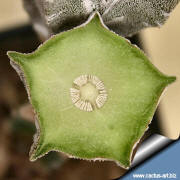|

Cross section of a
stem of
Astrophytum myriostigma
The pith (Medulla) is the whitish spongy
tissues encircled by the ring of
vascular
bundles
in the centre |
Pith is a light substance originating from the
ground meristem that is
found in vascular plants, it
is largely composed of spongy
parenchyma tissue modified for
storage, that has very little structural strength and is located in
the centre of the stem of the
Dicotyledons and in the non-woody
roots of
monocotyledon to the inside
of the stele.
It is encircled by a ring of xylem (woody
tissue), and outside that, a ring of
phloem (bark tissue). In most
plants the pith is solid, but some
plants, e.g. grasses and umbellifers,
the pith has a hollow centre forming a hollow tube except at the points
where leaves are produced, where there
is a solid plate across the stem. A few plants, e.g. walnut, have
distinctive chambered pith with numerous short cavities in the pith.
The pith varies in diameter from about 0.5 mm to 6-8 mm in solid pith of
woody plants, up to 30 mm in
succulent stem of
cacti or even 150 mm or more in the
stems of some plants with hollow pith, e.g. some bamboos.
Freshly grown pith in young new shoots is typically white or pale brown,
commonly darkening with age.
In woody plants (trees,
shrubs), the pith becomes surrounded
by successive annual rings of
wood -- it may be very inconspicuous but is always present at the centre
of a trunk or
branch.
Compare with: Cortex |